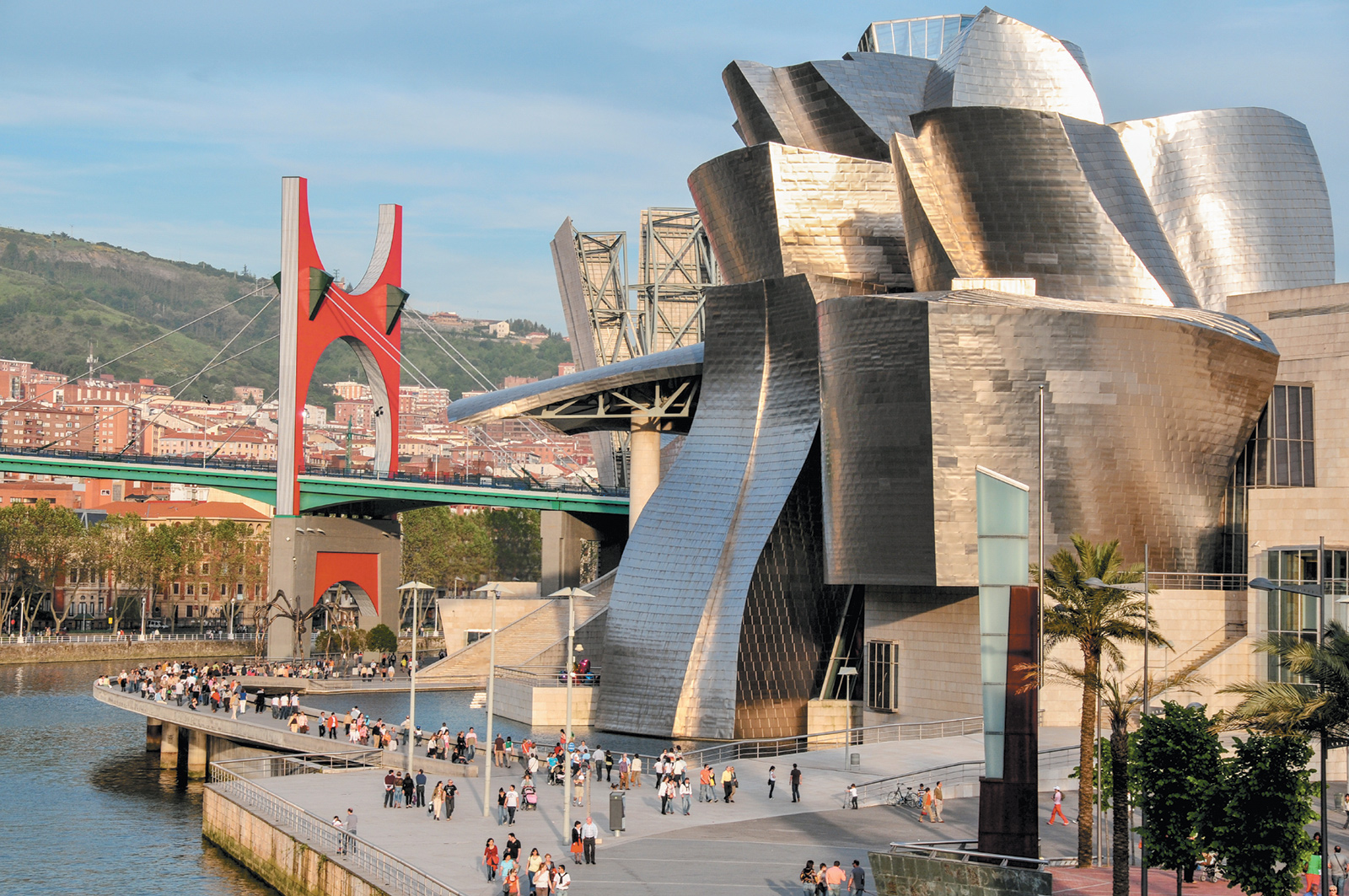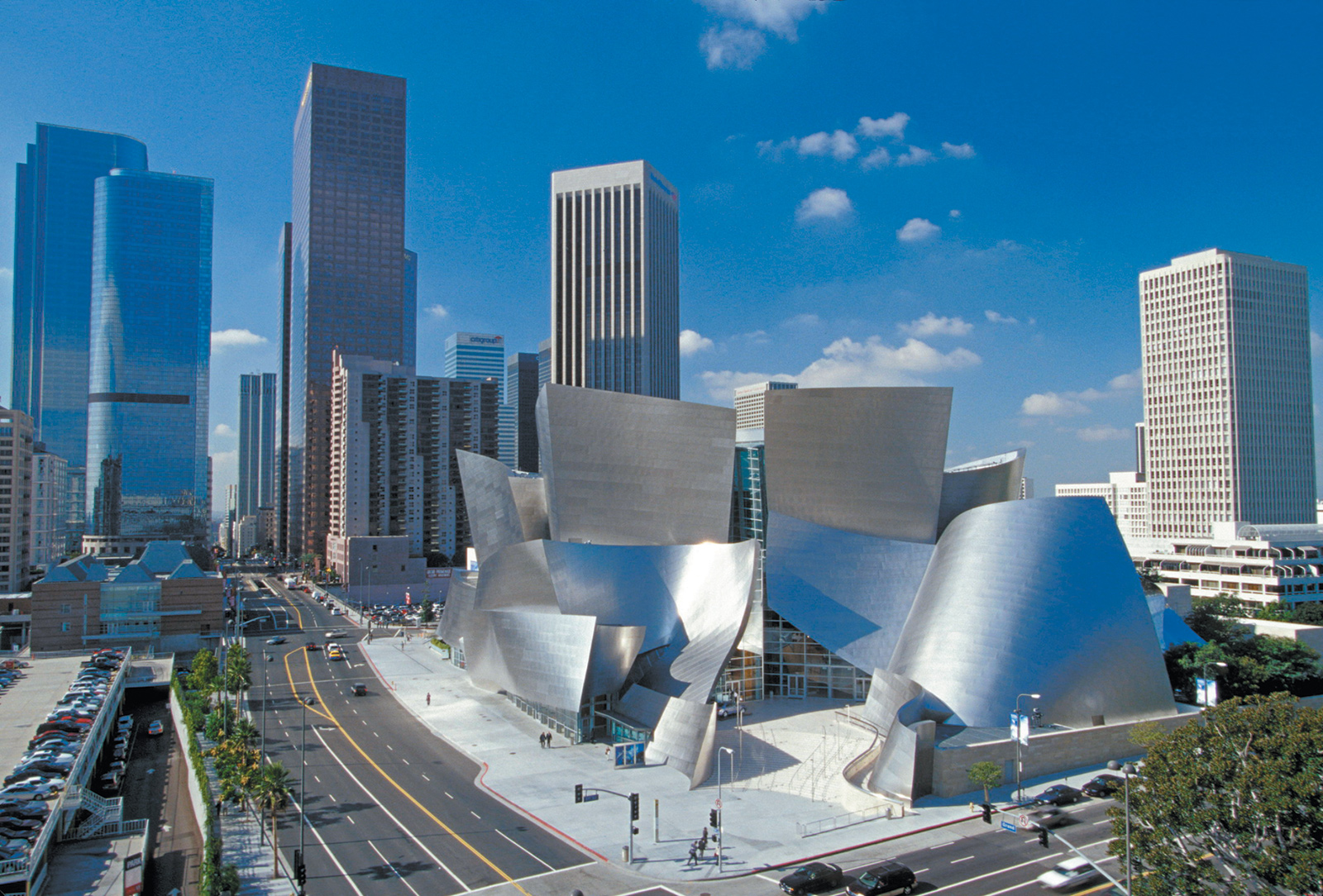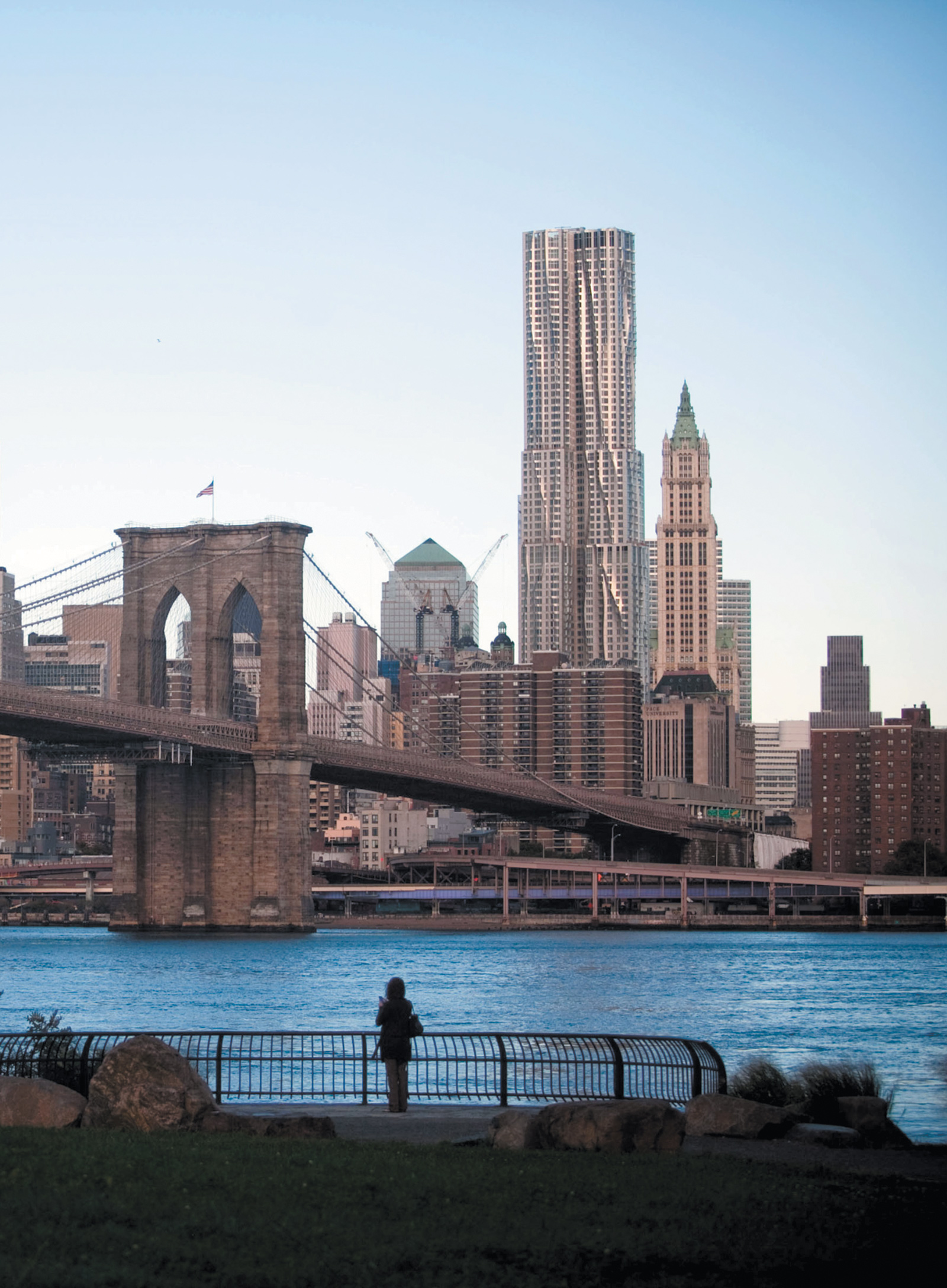Artists are a biographer’s nightmare. The most important events in their lives are usually the ones that take place quietly, slowly, in the repetitive actions of work, or within the sanctum of their skulls. Even Caravaggio, an artist with a penchant for swashbuckling exploits, spent as much time putting brush to canvas as he did making trouble, and his canvases finally tell us more about the man and his art than the police blotters recording his conflicts with the law.
The life of the architect Frank Gehry poses similar challenges. The real question his biographer needs to answer is the impossible one: how a sixtyish architect from Los Angeles ever came to imagine, much less build, the coppery metal carapace of the Guggenheim Museum in the heart of Basque country, in the declining port city of Bilbao. Before that 1997 project, and the subsequent plan to build a new concert hall in Los Angeles, Gehry was best known for constructing cheap buildings of cheap materials in the funky geometric shapes that began to punctuate the cityscape of Los Angeles in the disco era, one of them his own house on a placid residential street in Santa Monica.
The answer to these mysteries of creation has as much to do with what Gehry saw as with how he lived (he is a Toronto-born transplant to the West Coast who has had two wives and four children), or what kind of a person he might have been. In the case of Bilbao, he saw the dramatic promise of the site itself, a forested gorge that suddenly widens into an estuary making its serpentine way to the sea. Nineteenth-century Bilbao was laid out in regular blocks on the flood plain left by this bend in the Nervión River, to serve a burgeoning steel industry and a major port. Across the water, the maze of medieval Bilbao, a stop on the pilgrim road to Santiago de Compostela, huddled on a smaller sandbar beneath the limestone cliffs. Photographs of Gehry’s Guggenheim building rarely take in these natural surroundings, focusing instead on the tawny curves of the structure, clad in a combination of limestone and titanium panels. But Gehry himself was evidently looking at the view. The museum’s complex profile echoes the complexity of the hills around it, while its reflective façade takes on the colors of Bilbao’s perpetually changing sky.
But where did he get the idea for the object itself, for a metal-clad building composed of swelling, sweeping curvilinear planes? In part, certainly, from the great concrete sails of the Sydney Opera House, designed by Jørn Utzon, the building whose international impact the Basque authorities hoped to emulate by commissioning the Guggenheim project in the first place. But in Bilbao, along with the phantasmagoria of the landscape, there are also three exquisite little paintings by El Greco in the Fine Arts Museum, each of them presenting cloud constructions as abstract and powerfully architectonic as anything Gehry has conceived, and inspired, like the Guggenheim building, by the incomparable forms of nature, especially by those temperamental Spanish skies.
El Greco understood the structural power of his abstract shapes no less profoundly than Gehry, for he was an architect himself, as well as a painter and sculptor. His cloud constructions have made the same imaginative leap that Gehry’s built architecture began to make with the design of the Guggenheim Museum in Bilbao and of the Walt Disney Concert Hall in Los Angeles: a spring from the basics of post-and-lintel carpentry to building with abstract planes, each one unique, massed together to create spaces that are never hollow; instead, energy seems to funnel through them like an invisible liquid. On occasion, as in El Greco’s Burial of Count Orgaz (1586), a tiny human soul gets caught up in the windstorm, for the energy is divine, rushing eagerly back to its source.
If El Greco created painted cloudscapes as portals to heaven, Gehry, with the help of modern computer technology (and of the people who could handle those computers on his behalf), transformed his own spatial visions into matter and brought them down to earth. The effect can be exhilarating, but it can also be distinctly claustrophobic. In his new biography, Building Art, Paul Goldberger repeats a story he heard from Gehry about the architect’s new friend Lillian Hellman:
He invited her to a large dinner party he and Berta [Gehry’s wife] were giving at the house. Hellman arrived and asked where the powder room was. She disappeared, emerged just before dinner was served, and sat down at the table. After five minutes she got up, said she was not feeling well, and departed.
Not long afterward Frank and Hellman encountered each other at another party. Hellman, Frank remembered, leaned over to him and said, “You’re mad at me—you haven’t called me.”
“No,” Frank said. “The last time I saw you was the night you weren’t feeling well and you left my house.”
She was actually feeling fine that night, Hellman told him. “I hated it,” she said. “That’s why I left—because I hated your house.”
The house in question is a pink Dutch-style bungalow surrounded with chain-link fencing, corrugated tin, and glassed-in lean-tos at crazy angles. Because of their odd orientations, the glassed-in sections call attention to the unusual forms of their enclosure rather than to their views to the outside. The atrium of the Guggenheim Museum in Bilbao repeats some of the same themes, including the crazy angles and the glassed-in bundles of upright supports, and despite its colossal scale it, too, reads from the inside as a hermetically sealed space, a greenhouse rather than a dome of heaven.
Advertisement
Goldberger’s biography has its own hermetic feel as well, from its dust jacket, showing a diminutive black-clad Gehry caged behind the silver-embossed image of his first sketch for Bilbao, to the book’s insistence, punctual as a drumbeat, that “Frank” is the most famous architect of our time:
He was arguably the most famous architect in the world….
He had designed the most talked-about house in Los Angeles, if not in the entire country, and he had become, by default if not by design, the central figure around whom the growing community of cutting-edge architects in Los Angeles revolved. But how was he going to stay fresh, and stay ahead of the next generation?…
There could be no doubt now of his stature: not just an international figure, he was looking more and more like the most important architect anywhere….
The [Bilbao] organization had not yet even made a decision to build a new building, and one of the most famous architects in the world had all but proposed himself for the job.
As a biographer, Goldberger has made two strategic decisions. Firstly, he has chosen to stick closely to Gehry’s own point of view, basing his narrative on an extended series of interviews. Secondly, he decided not to spend any protracted time in Los Angeles while he was writing the book, but rather to commute back and forth from the East Coast.
As a result, we, poor readers, have no room to move. We are trapped within the contradictions of Gehry’s own unresolved personality, in which his inveterate self-image as “a do-gooder, liberal to the core” does ceaseless battle with a career conspicuously devoted to the service of wealth and celebrity. We hear again and again what a great friend Frank is to everyone he meets, but cannot help noting that his road to Olympus is littered with the bodies of associates, friends, and projects that “didn’t work out.”
In short, Building Art has sacrificed critical distance, either because its author is completely in awe of his subject, or in order to keep from offending that subject’s touchy sensibilities. For it quickly emerges that if we do not love everything that Frank has ever designed with an unconditional love, we shall hurt his feelings and incur his wife’s implacable hatred. We also begin to sense, fairly early on, that it is not really our place as users of architecture to judge the work of architects. Goldberger and his subject both assert, implicitly and explicitly, that if we do not adore Frank Gehry and his architecture with all our heart and all our soul and all our might, we are as blind and stupid as Samson among the Philistines, as querulous as Thersites among the heroes of Troy.
The most egregious expression of this attitude comes late in the book, when a jet-lagged Gehry, already in his eighties, must make his way to a Spanish press conference from an interrupted nap:
The first reporter asked him what his response was to charges that his buildings were more in the line of dazzling spectacles than functional architecture. This time, he was too tired to be polite. He extended his middle finger. There was an awkward silence, and then another reporter asked whether “emblematic” buildings would continue to be a feature of cities. Frank replied with only slightly more patience than he had shown to the previous questioner. “In this world we are living in, 98 per cent of everything that is built and constructed today is pure shit,” he said. “There’s no sense of design, no respect for humanity or for anything else. Once in a while, however, a group of people do something special. Very few, but God, leave us alone. We are dedicated to our work…. I work with clients who respect the art of architecture. Therefore, please don’t ask questions as stupid as that one.”
Goldberger declares that:
Advertisement
It was a trivial incident, funny more than scandalous, and mainly a reminder that Frank’s celebrity had reached a point where his every gesture would be noticed, and sometimes blown out of proportion. Lost in the discussion were the questions that he was trying, through his exhaustion, to communicate.
But the incident was neither trivial, nor funny, nor the product of Frank’s celebrity. The elderly, famous architect snapped, with shocking rudeness, because the reporters’ questions, far from being stupid, pierced through to the essence of his imperfect art.
Among the arts, architecture is the most compromised, the most hemmed-in of them all, in thrall to human communities, to the law of gravity, and to the Second Law of Thermodynamics, which proclaims that all things, including buildings, shall inevitably fall apart. Like the people they serve, architects and their works are creatures of time, place, and climate. In the specific case of Frank Gehry, space, time, and climate all converged in Los Angeles, that seismic zone of sun, smog, and fantasy, a place where a building can be not only four walls, but also a ziggurat, a dinosaur, a doughnut, a stack of 45 rpm records, a hot dog, or a big brown hat.
More than any other force, Los Angeles is the furnace that forged Frank Gehry’s brain, and thus the current Gehry retrospective at the Los Angeles County Museum of Art (LACMA) starts with an open letter of thanks—from the very Frank himself—to the city and its people. Goldberger may be an eminent critic of architecture, but he is also an inveterate East Coaster who begins his biography with the architect’s eighty-second birthday party (and all-but-apotheosis) atop a needle skyscraper in Manhattan, the one the Gehry studio continues to call “8 Spruce Street” but that its developer markets to customers as “New York by Gehry.” Brad Pitt may have given his Olympian chrism to this glittering event, and certainly a part, a very big part, of Gehry craves this high life, but surely there is much more to learn about the man and his career in a smallish exhibition just off the LACMA retrospective (in a Renzo Piano building, no less!): a show of Japanese scrolls installed by Gehry to honor his very first commission for the museum in distant 1965.
That first commission was also the design for an exhibition of Japanese scrolls, a reminder that Los Angeles may look like a backwater to Manhattanites, but on its own unstable ground it has been for decades the gateway to Asia and, through Asia, to the future. In the case of Frank Gehry, the buildings that will continue to distinguish his career are not to be found in New York. There will always be two: a museum in what had been an out-of-the-way Spanish port and the Los Angeles concert hall in the epicenter of La-La Land.
The original County Museum buildings were designed by William Pereira (Chicago 1909–Los Angeles 1985), the visionary architect who, among many other accomplishments, also taught at the University of Southern California. There he met a talented young man named Frank Goldberg and eventually served as his adviser. Later, when Frank Goldberg had changed his name to Frank Gehry, Pereira hired him. The influence of this important midcentury figure goes far beyond what either Gehry or Goldberger (confined as he is to Gehry’s viewpoint) is willing to credit.
Pereira won an Oscar in 1943 for Special Effects (his brother Hal was an art director and production designer for the movies) and appeared on the cover of the September 6, 1963, issue of Time under the banner “Vistas for the Future” in connection with his plans for developing the vast Irvine Ranch into a new city in Orange County, California, a master plan that included a new branch of the University of California.
Pereira’s work combined, therefore, the imaginative freedom of Hollywood with the practicality of construction. He experimented boldly with the possibilities of cast concrete, creating buildings that consumed a minimum of energy at a time when energy seemed to be in infinite supply. Pereira’s most radical designs include fanciful buildings like the Transamerica Pyramid in San Francisco, the spidery Theme Building of Los Angeles International Airport, and the Ziggurat (now the Chet Holifield Federal Building) in the Southern California settlement of Laguna Niguel. But he also built a host of more low-key modernist structures that fit more sociably into their surroundings, including the central campus of the University of California, Irvine, now fifty years old.
One one hand, Goldberger presents William Pereira as the architect who “would in some ways haunt Frank for years to come,…an architect remembered for the occasional bold shapes he had managed somehow to persuade clients to build.” Yet he liquidates Pereira’s LACMA complex as “somewhat vapid,” and the Dorothy Chandler Pavillion at the Los Angeles Music Center as “banal.” How, in a city where “banal” might describe anything from In-N-Out Burger to a glass-fronted office box, do we connect this building with Pereira the inventor of fanciful geometries? In Goldberger’s paraphrase, Gehry presents Pereira as a negative example for future practice, but the account sounds more like an unwitting self-portrait:
Left to his own devices, Frank realized, Pereira was driven more by a desire to make memorable shapes than by a clear understanding of his clients’ needs…. Frank began to think of Pereira…as an architect who mainly invented shapes out of his imagination and then tried to persuade his clients to accept them.
In 2005, the University of California, Irvine, decided (not without controversy) to demolish its nineteen-year-old Gehry-designed lecture hall, which derived from his period of cheap construction materials and had never worked very well. Pereira’s buildings on the same campus are still standing, and his original overall design is still in place.* In the ever-negotiated field of architecture, to architects’ eternal frustration, we users not only have a right to judge the quality of a building. We have the only right.
Pereira, moreover, provides the most cogent high-culture model for what Gehry eventually created in Bilbao, which was not, as that annoying Spanish reporter understood perfectly, an art museum. It was another time-honored Los Angeles building type, the roadside attraction. This distinction becomes clear to anyone who visits Bilbao’s “other” art museum, the Fine Arts Museum enlarged in the 1990s by Luis Uriarte, set in the center of the nineteenth-century city inside a verdant public park.
Both structures have ostensibly been designed to house the work of the Basque sculptor Eduardo Chillida, but there is no comparison between the light-filled venue that Luis Uriarte provides for the city museum and the dim caverns where Chillida’s work resides in Gehry’s Guggenheim. In the video connected with his work for the Guggenheim Bilbao, sculptor Richard Serra claims that his massive cast steel sculptures are the only way to keep the vast hall that houses them from looking like a factory floor. He and Gehry, once friends, now snipe at each other mercilessly, but in this case Serra has a point. The shell and its contents by Serra work as art together, and only together. The café in the city museum is a genuine meeting point for the people of Bilbao, looking onto glorious greenery. The café at the Guggenheim looks at the underside of the billboard-like sign announcing its presence and the posterior of Jeff Koons’s topiary colossus, Puppy.
With the help of some exceptionally clever city planners, the Guggenheim has put Bilbao back on the map, gracefully, engagingly, but in the same beckoning vein as the crudely monumental golfer who stood watch for several decades over the San Diego Freeway (he now holds an automobile muffler). The most curious part of the Guggenheim Bilbao, the freestanding tower that stands athwart the suspension bridge that brings the BI-625 highway into the city center, looks from the inside like a trio of billboards, with the added lure that pedestrians can climb up inside them.
It was Gehry’s divine flash of intuition to choose the Guggenheim’s riverside site, an abandoned factory, and to embrace the challenge of the bridge. Los Angeles supplied him with the know-how to make the intersection of road and building work. He had only to think how the exaggerated Florentine design of the 1925 Patriotic Hall of Los Angeles showed to such perfect advantage from the freeway, or of the Assyrian-revival tire factory transformed in latter days into the Citadel Outlets. It was the Basque government’s brilliance to call the nearest tram stop “Guggenheim” while placing it next to another feature entirely: the Pedro Arrupe footbridge that connects the city center to the university. Bilbao has worked for everybody, but most of all for the Bilbainos. Gehry has been instrumental in the city’s transformation but he was hardly alone.
Gehry’s retrospective exhibition at LACMA, like his biography, is full of contradictions. He claims that his early house projects are inspired by the paintings of Giorgio Morandi, those obsessive assemblages of bottles that seem to vibrate in space, but in fact the drawings look as if they have been equally inspired by the buildings of Aldo Rossi, inspired in his own right by the paintings of Giorgio Morandi. It is easy for Gehry to credit artists. He has more trouble with architects.
Can he really have designed his loopy, double-lobed “Fred and Ginger” apartment house in Prague without having looked at Friedensreich Hundertwasser’s even loopier public housing project, the Hundertwasserhaus, in Vienna? His building at 8 Spruce Street in Manhattan may credit the Baroque sculptor Gian Lorenzo Bernini for its pleated surface, but its abrupt sideways shift is a move Rem Koolhaas already tried in Rotterdam.
There is a Michael Graves feel to some of Gehry’s work for Loyola Law School and in some of his early houses. And it is gratifying to read that in 2000 he wrote a letter recommending Graves for the Gold Medal of the American Institute of Architects, the award he himself had won in 1999 (Graves won in 2001). But the Frank Gehry teakettle on sale at his retrospective costs $500, and with its massive mahogany handle it is hard to see using it for anything but decoration. Michael Graves, on the other hand, sold his teakettle design through Target as well as the upscale Italian designer Alessi (who also produced Gehry’s kettle) to make it available to everyone. Its design aimed to boil water as quickly as possible.
It is also difficult, when watching Sydney Pollack’s 2006 film Sketches of Frank Gehry, not to compare it with a documentary of Graves made late in his life, when paralysis gave him a new insight into designing houses for handicapped veterans and autistic children. In one scene, Pollack shows the goateed painter Julian Schnabel (one of the Guggenheim collection’s anointed) in a terrycloth bathrobe and sunglasses, stretched out on a chaise longue, brandy snifter in his right hand, cigar in his left, looking for all the world like a hairy Olympian sipping his nectar. And then there was the autistic boy in the Graves documentary who simply said, “I never knew that anyone would design something for me.”
When it first opened, Gehry’s Disney Hall, with its stainless steel cladding, was so bright that the flashy exterior blinded the neighbors. It had to be darkened. Buildings that scream for attention can be fun, provocative, even inspirational, but they are not the stuff that most architecture can be made of. Michael Graves understood that in his wise old age. The young Chilean architect Alejandro Aravena understands it now, as the Pritzker Prize committee recognized in its 2016 award, saying that he perceives “the importance of poetry and the power of architecture to communicate on many levels.” If the poetry and the power of architecture do not communicate on many levels, from Olympus down to the humblest among us, they do not communicate at all. Which is why Frank Gehry, raw, tired, angry, and eighty, shot up his middle finger when confronted with the truth, and why he looks so crabby on the cover of his hagiography.
This Issue
March 24, 2016
Solving the Mystery of the Schools
Looking for Citizen Welles
-
*
See Sara Lin, “Campus Is Willing to Live Without Gehry,” Los Angeles Times, September 1, 2005. Pereira’s legacy may be in danger now; see Alan Hess, “Erasing Pereira,” Orange Coast, June 30, 2014. Pereira’s Irvine office, Urbanus Square, was torn down in the 1990s to realign and extend a local road to link with the San Joaquin Hills toll road. ↩






